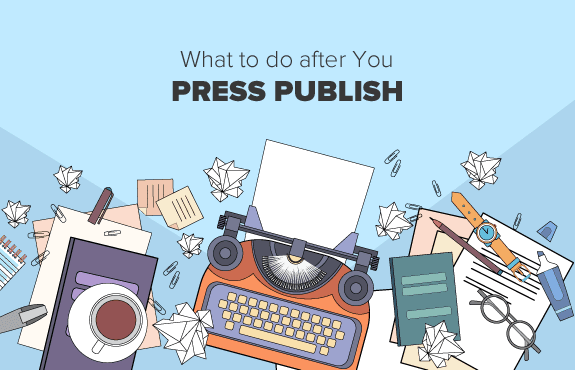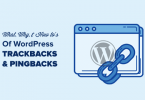Today I want to share what I do after I publish a post. It’s definitely a little bit more than hitting the publish button. In this article, I’ll share the 11 things you absolutely must do after publishing your blog post. These tips will help you maximize the value of each blog post that you write.
Since I know this is a very valuable resource, I suggest bookmarking this page or using this guide to create a customized checklist for you. Having said that, here are the 11 things to do after you publish your blog post.
- Reread and Revise: I’m sure you invest some time in editing your posts before you publish, but if you’re like most bloggers then you’ll likely miss something. That’s why you should proofread and revise again after you publish the post.
- Share it on Your Social Profiles: Immediately after publishing, go ahead and send out your first tweet, share it on your Facebook profile/page, and any other network that you’re active on. This will help you get early traction. Not sure which networks you should focus on? You spent hours writing the article, you should spend a few minutes promoting them to get maximum exposure.
- Send it to Your Email Newsletter: Your email subscribers are the most loyal because they’ve given you permission to let them know about the content you write. So email them and let them know. You can automate this by setting up daily / weekly newsletters. If you don’t have an email list, then you should build one right away.
- Share it in Groups / Aggregators: I’m sure you are part of different Facebook or LinkedIn groups. You might even be part of a private Slack channel. If you are part of subreddits or industry-specific communities like Inbound, then you should submit your articles there for additional reach.
- Link from Old Posts: If you publish a lot of evergreen content that continues to attract clicks and shares over time, then you can leverage these old posts to drive traffic to new posts. Simply go back through your most popular posts and find ways to incorporate links to the post you just published. Not only does this increase direct traffic, but it also establishes a strong SEO framework for your website.
- Reply to Comments: Getting people to comment on your posts is incredibly challenging in the first place. That’s why you never want to ignore a comment. Make it a priority to respond to every single comment posted. This establishes a positive rapport with your readers and since comments are searchable on Google, the more conversation that takes place in the comments section, the better your search results will be. Not to mention, it shows a higher total comment count which encourages new users to comment.
- Syndicate Through Partners: As you publish more and more content, you should start to develop relationships within your content niche. Over time, these connections can blossom into guest blogging opportunities and even syndication relationships. If you’ve managed to develop syndication partnerships, you’ll want to use them as much as possible. After publishing a post, reach out to your connection and ask them to give your post a read. If they like it, let them know that you’re willing to syndicate through their publishing platform. This can save you hours of time and expand your reach exponentially. To prevent duplicate content, you want to ensure that there’s a mention at the top of the post saying “this article originally appeared on Yoursite.com” with a link to your article. You should also get an author bio with a link back to your site. Lastly, if they can add a canonical link to your site, then that’s even better. Google canonical link, if you don’t know what I’m talking about.
- Repurpose into Other Formats: You should never publish a blog post and then leave it to die. Any post that’s longer than 800-1000 words can easily be repurposed into another format for additional value. How? Well, you can use it as the script for a video, divide it up and use it for a handful of shorter posts, turn it into the basis for a podcast episode, convert it into an eBook/checklist, and more. While repurposing takes time, the benefit is that you already have the core subject matter developed. This streamlines the process and allows you to maximize your effort.
- Schedule Social Sharing: Most people only share their articles once or twice right after it’s published. It’s important to do that which is why Item #2 is dedicated to that. However, you shouldn’t just stop sharing the article after the first day. More likely than not, the article you wrote is relevant at least for the first week if not longer. That’s why I recommend scheduling your posts to be shared months in advance. Now there are several tools/services that will let you do this, but I use Buffer because why pay extra when you don’t have to. Buffer lets me schedule tweets and other shares, and I can set it to go out say 4 times a day at 8a, 12p, 4p, and 7p. You can change the frequency of your account. Now all you have to do is create a text or CSV file with all your blog posts and schedule it. You can update your list every month (the task is so simple, you can even outsource it). If you’re looking for alternatives, then you can take a look at CoSchedule, Revive Old Post, or Social Oomph.
- Outreach / Favors: Blogging is all about building healthy and mutually beneficial relationships. If you’ve spent time reading, commenting on, and sharing other people’s posts, then you’ve probably developed some strong relationships with others in your niche. When you feel like you’ve posted a particularly strong piece, don’t be afraid to reach out and ask for a favor. If they value your relationship, then they’ll be happy to share the post with their followers. If you are just starting out and not sure who you should reach out to, then you can use a tool like BuzzSumo to see who shared your competitor’s content as well as find influencers on a specific topic.
- Study the Numbers: Finally, keep an eye on the numbers. Your blog analytics will tell you a lot about where your traffic is coming from, how many pages views you’re getting, how long readers are actually staying on the page, etc. This information can then be used to tweak future blog sharing strategies. Not sure how to get this data? I have a plugin called Monster Insights that can help with this. It’s been downloaded over 11 million times – give it a try. I hope this article helped you maximize your content marketing efforts.
If you liked this article, then please consider sharing it with your friends.
The article was published on December 8, 2018 @ 10:57 AM





Leave a Comment